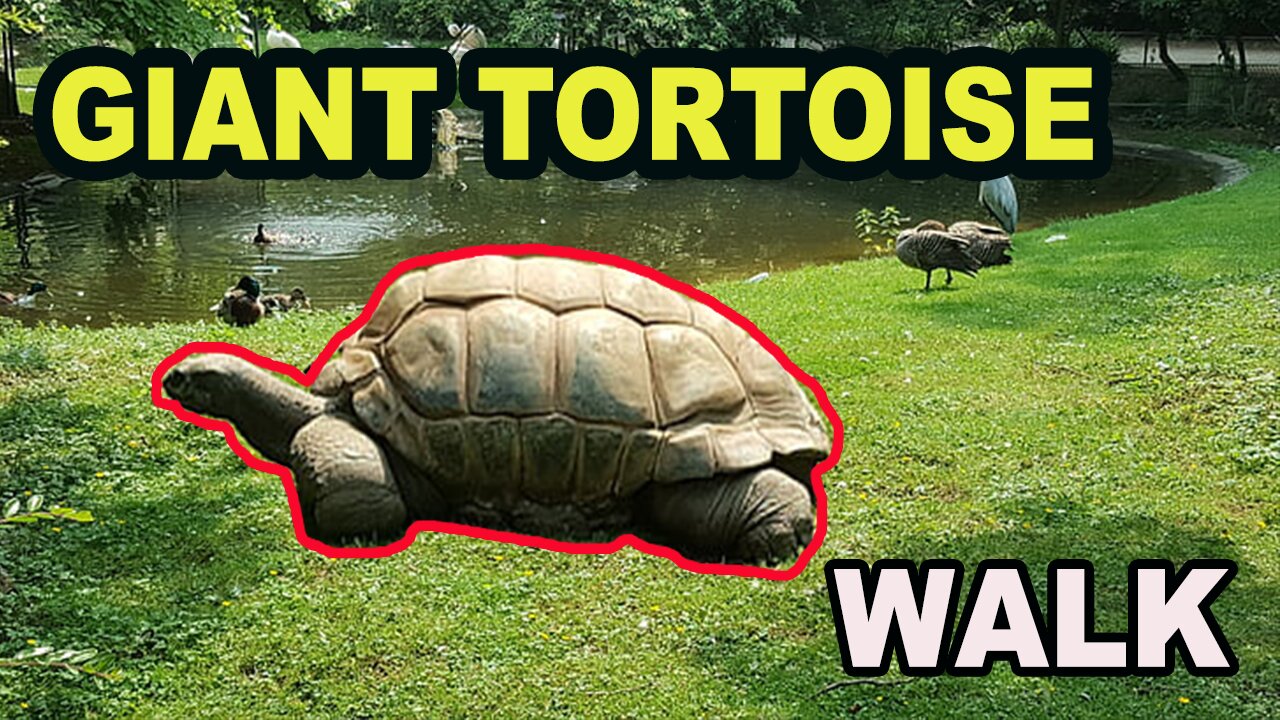Premium Only Content

Giant Tortoises' amazing movement speed
The giant tortoise is an iconic species from the Galápagos and is only found on these islands. They are the largest living tortoise in the world.The Aldabra giant tortoise (Aldabrachelys gigantea) lives on the remote Aldabra Atoll, one of the Seychelles group of islands in the Indian Ocean It is the only living species in the genus Aldabrachelys. Two other species in the genus, Aldabrachelys abrupta, and Aldabrachelys grandidieri were formerly endemic to Madagascar, but became extinct after the arrival of people.Aldabra giant tortoises have large dome-shaped shells in order to protect their delicate bodies that lie beneath their shells. They also have long necks in order to eat leaves from the higher branches of trees. The males, although not much bigger than the females, weigh nearly 100 kg (220 lbs) more. They move slowly and have small, thick legs and round, almost flat feet that assist them in walking on sand.
The Aldabra giant tortoise mainly inhabits grasslands and swamps on Aldabra Atoll's islands, which form a part of the Seychelles island chain in the Indian Ocean. In the past, they shared the islands with multiple other giant tortoise species, but many of them were hunted to extinction in the 1700s and 1800s.[citation needed] Despite the fact that they are usually found in regions of dense low-lying vegetation, they have been known to wander into areas with more sparse vegetation and rocks when food is scarce. They can also be seen resting in shaded areas or shallow pools of water in order to cool themselves on hot days.[22][better source needed] Aldabra giant tortoises tend to spend their lives grazing, but will cover surprising distances in search of food and have also been observed on bare rock and thin soil. They can drink from very shallow pools through their nostrils; the former genus Dipsochelys refers to this adaptation.[23][full citation needed]Galápagos tortoises are herbivorous, feeding primarily on cactus pads, grasses, and native fruit. They drink large quantities of water when available that they can store in their bladders for long periods of time. There are two main types of shell among them, the saddle-backed shell and the domed shell. They both provide special adaption to different environments. The saddle-backed tortoises are the smallest Galápagos tortoises, but present a very long neck and pairs of legs. They live on arid zone and feed on cactus. The domed tortoises are bigger with shorter neck and legs, they are found in the more vegetated islands and feed on grass.[27] They spend an average of 16 hours a day resting. Their activity level is driven by ambient temperature and food availability. In the cool season, they are active at midday, sleeping in in the morning and afternoon. In the hot season, their active period is early morning and late afternoon, while midday finds them resting and trying to keep cool under the shade of a bush or half-submerged in muddy wallows.Tortoises breed primarily during the hot season from January to May; however, tortoises can be seen mating any month of the year. During the cool season (June to November), female tortoises migrate to nesting zones, which are generally located in low lands of the islands, to lay their eggs. A female can lay from 1–4 nests over a nesting season from June to December. She digs the hole with her hind feet, then lets the eggs drop down into the nest, and finally covers it again with her hind feet. The number of eggs ranges from 2 to 7 for saddle-backed tortoises to sometimes more than 20 to 25 eggs for domed tortoises. The eggs incubate from 110 to 175 days (incubation periods depend on the month the clutch was produced, with eggs laid early in the cool season requiring longer incubation periods than eggs laid at the end of the cool season, when the majority of their incubation will occur at the start of the hot season). After hatching, the young hatchlings remain in the nest for a few weeks before emerging out a small hole adjacent to the nest cap. Usually, the temperature of the nest influences on the sex of the hatchling. Warm temperatures would yield more females, while colder temperatures would yield more males
-

TheSaltyCracker
2 hours agoLefty Grifters Go MAGA ReeEEeE Stream 12-22-24
45.8K75 -
 13:24
13:24
Matt Kohrs
1 hour agoBreaking News! Rumble Secured MASSIVE $775M Partnership
1.99K5 -

Rance's Gaming Corner
6 hours agoTime for some RUMBLE FPS!! Get in here.. w/Fragniac
107K1 -
 DVR
DVR
Josh Pate's College Football Show
6 hours ago $2.83 earnedCFP Reaction Special | Early Quarterfinal Thoughts | Transfer Portal Intel | Fixing The Playoff
16.1K -
 23:55
23:55
CartierFamily
3 days agoElon & Vivek TRIGGER Congress as DOGE SHUTS DOWN Government
61.3K75 -
 5:43:44
5:43:44
Scammer Payback
2 days agoCalling Scammers Live
146K21 -
 18:38
18:38
VSiNLive
2 days agoProfessional Gambler Steve Fezzik LOVES this UNDERVALUED Point Spread!
109K17 -
 LIVE
LIVE
Right Side Broadcasting Network
10 days agoLIVE REPLAY: President Donald J. Trump Keynotes TPUSA’s AmFest 2024 Conference - 12/22/24
5,052 watching -
 4:31
4:31
CoachTY
1 day ago $26.84 earnedCOINBASE AND DESCI !!!!
147K11 -
 10:02
10:02
MichaelBisping
23 hours agoBISPING: "Was FURY ROBBED?!" | Oleksandr Usyk vs Tyson Fury 2 INSTANT REACTION
84.1K13